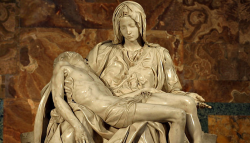Venice emerged from its medieval past in the fifteenth century to become one of the greatest cities in Italy.
Venice developed as a city unlike that of any other in Italy. Whereas other cities in the peninsula could say they were founded by the ancient Romans, and thereby claim an ancestry related to Rome, Venice could not. The city was founded in the early Middle Ages by people fleeing attackers such as the Lombards, who pushed the future Venetians onto the series of islands and mudflats located just off the coast of the north Adriatic Sea. There, around the year 421 (the legendary foundation date of the city), the new residents would build their new world on these islands and the series of wooden piles and foundations that were needed to support the growing urban setting.
During the early years of Venice’s existence, it was protected and affiliated with the greatest power in the Mediterranean of the early Middle Ages, the Byzantine Empire, which had its capital in Constantinople. By the ninth century, Venice began to assert some independence from Byzantium, although the two powers still enjoyed a close relationship which led to the replication of Byzantine forms and spaces within Venice. The next several centuries would prove to be highly fortuitous to Venice as she completely emerged from her Byzantine shadows to assert her own claim to being a major maritime power in the Mediterranean. Because Venice is located on the northern end of the Adriatic, she had seafaring access to lands far and wide, which enabled her to trade with cities in north Africa, the Levant, and up into the Black Sea. Once goods flowed into Venice, they could then be sold to people from other parts of Italy and around Europe. Thus, Venice’s engine for growth was built around its status as a commercial center.
The culminating point in Venice’s medieval history was its sack of Constantinople in 1204. Joining with French Crusaders en route the the Holy Land, and Venetians helped conquer the city of its once-friendly-ally, removed the Byzantine emperor from power, and installed their own western emperor. This situation would last until the Byzantines thew out their occupiers in 1261, but it reveals just how strong Venetian power had now become. After the sack, numerous spoils were removed from Byzantine territories and brought back to Venice, where they were installed as a means of recreating aspects of the Byzantine world in Venice. With the inflow of wealth and Byzantine artifacts, Venice was able to expand its main urban space around the Piazza San Marco and heavily decorate its basilica there, the Basilica San Marco.
Because Venice’s fortunes were so reliant upon sea trade, the city began to suffer when trade became more difficult as the House of Islam expanded to control more and more land around the eastern Mediterranean. Venice’s trading posts around the Greek isles suffered, and the final nail was put in place when the city of Constantinople fell for good to the Muslims in 1453. The Venetian response to this threat from the sea was to turn to the land in the northern Italian region surrounding the city. By the early sixteenth century, Venetian inland territories (the “terraferma”) expanded so that Venetian patricians, who once made their money by investing in trading expeditions with the East, now were content to receive income by investing in agricultural production. This Venetian expansion into the Italian peninsula did not, however, go unnoticed by the other reigning powers in Europe. Alarmed by the new inland focus of the city, several powers joined together to confront Venice, at at the Battle of Agnadello in 1510, Venetian forces were conquered and many of the gains the city had made were reduced.





